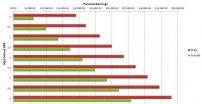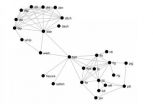(Press-News.org) Shenzhen, May 18, 2014---Chinese scientists from Chinese Academy of Agricultural Sciences and BGI successfully deciphered the genome sequence of another diploid cotton-- Gossypium arboreum (AA) after the completed sequencing of G. raimondii (DD) in 2012. G. arboreum, a cultivated cotton, is a putative contributor for the A subgenome of cotton. Its completed genome will play a vital contribution to the future molecular breeding and genetic improvement of cotton and its close relatives. The latest study today was published online in Nature Genetics.
As one of the most important economic crops in the world, cotton also serves as an excellent model system for studying polyploidization, cell elongation and cell wall biosynthesis. However, breeders and geneticists remain little knowledge on the genetic mechanisms underlying its complex allotetraploid nature of the cotton genome (AADD). It has been proposed that all diploid cotton species present may have evolved from a common ancestor, and all tetraploid cotton species came from interspecific hybridization between the cultivated species G. arboreum and the non-cultivated species G. raimondii.
After the completed sequencing of G. raimondii in 2012, researchers started the work on decoding the genome of G. arboreum. In this study, they sequenced and assembled the G. arboreum genome using whole-genome shotgun approach, yielding a draft cotton genome with the size of 1,694 Mb. About 90.4% of the G. arboretum assembled scaffolds were anchored and oriented on 13 pseudochromosomes.
Furthermore, researchers found the long terminal repeat (LTR) retrotransposons insertions and expansions of LTR families contributed significantly to forming the double-sized G. arboreum genome relative to that of G. raimondii. Further molecular phylogenetic analyses suggested that G. arboreum and G. raimondii diverged about 5 million years ago, and the protein-coding capacities of these two species remained largely unchanged.
To investigate the plant morphology mechanisms of cotton species, a series of comparative transcriptome studies were performed. Results suggested that NBS-encoding subfamilies played an essential role on the immune to Verticillium dahliae. The resistance of G. raimondii on Verticillium dahliae was caused by expansion and contraction in the numbers of NBS-encoding genes, accordingly the loss in the genome of G. arboreum was responsible to their susceptible.
Another interesting finding of this study is the cotton fiber cell growth, and they found the 1-aminocyclo-propane-1-carboxylic acid oxidase (ACO) gene was a key modulator. Researchers suggest the overproduction of ACO maybe the reason why G. raimondii have a poor production of spinnable fiber, while the inactivation of ACO in G. arboreum might benefit its fiber development.
The G. arboreum genome will be an essential reference for the assembly of tetraploid cotton genomes and for evolutionary studies of Gossypium species. It also provides an essential tool for the identification, isolation and manipulation of important cotton genes conferring agronomic traits for molecular breeding and genetic improvement.
INFORMATION:
About BGI
BGI was founded in 1999 with the mission of being a premier scientific partner to the global research community. The goal of BGI is to make leading-edge genomic science highly accessible through its investment in infrastructure that leverages the best available technology, economies of scale, and expert bioinformatics resources. BGI, which includes both private non-profit genomic research institutes and sequencing application commercial units, and its affiliates, BGI Americas, headquartered in Cambridge, MA, and BGI Europe, headquartered in Copenhagen, Denmark, have established partnerships and collaborations with leading academic and government research institutions as well as global biotechnology and pharmaceutical companies, supporting a variety of disease, agricultural, environmental, and related applications.
BGI has established a proven track record of excellence, delivering results with high efficiency and accuracy for innovative, high-profile research which has generated over 250 publications in top-tier journals such as Nature and Science. These accomplishments include sequencing one percent of the human genome for the International Human Genome Project, contributing 10 percent to the International Human HapMap Project, carrying out research to combat SARS and German deadly E. coli, playing a key role in the Sino-British Chicken Genome Project, and completing the sequence of the rice genome, the silkworm genome, the first Asian diploid genome, the potato genome, and, most recently, have sequenced the human Gut metagenome, and a significant proportion of the genomes for 1,000 genomes. For more information about BGI please visit http://www.genomics.cn.
Contact Information:
Bicheng Yang, Ph.D.
Public Communication Officer
BGI
+86-755-82639701
yangbicheng@genomics.cn
http://www.genomics.cn
Chinese scientists crack the genome of another diploid cotton Gossypium arboreum
The latest study was published online in Nature Genetics
2014-05-19
ELSE PRESS RELEASES FROM THIS DATE:
The young sperm, poised for greatness
2014-05-19
SALT LAKE CITY— In the body, a skin cell will always be skin, and a heart cell will always be heart. But in the first hours of life, cells in the nascent embryo become totipotent: they have the incredible flexibility to mature into skin, heart, gut, or any type of cell.
It was long assumed that the joining of egg and sperm launched a dramatic change in how and which genes were expressed. Instead, new research shows that totipotency is a step-wise process, manifesting as early as in precursors to sperm, called adult germline stem cells (AGSCs), which reside in the testes. ...
'Smoking gun' evidence for theory that Saturn's collapsing magnetic tail causes auroras
2014-05-19
University of Leicester researchers have captured stunning images of Saturn's auroras as the planet's magnetic field is battered by charged particles from the Sun.
The team's findings provide a "smoking gun" for the theory that Saturn's auroral displays are often caused by the dramatic collapse of its "magnetic tail".
Just like comets, planets such as Saturn and the Earth have a "tail" – known as the magnetotail – that is made up of electrified gas from the Sun and flows out in the planet's wake.
When a particularly strong burst of particles from the Sun hits Saturn, ...
Solar energy prospects are bright for Scotland, experts say
2014-05-19
Installing state-of-the-art solar panels on a quarter of a million roofs could meet one-sixth of Scotland's electricity demands, experts say.
Scientists say the strategy could ease the plight of one in three Scottish households, which currently struggle to provide themselves with adequate heat and hot water.
Researchers, business leaders and public sector experts have contributed to a report which sets out how Scotland could benefit from solar power.
They say harnessing energy from the sun on the roofs of south-facing buildings could have significant economic, ...
Antarctica's ice losses on the rise
2014-05-19
Three years of observations show that the Antarctic ice sheet is now losing 159 billion tonnes of ice each year – twice as much as when it was last surveyed.
A team of scientists from the UK Centre for Polar Observation and Modelling, led by researchers at the University of Leeds, have produced the first complete assessment of Antarctic ice sheet elevation change.
They used measurements collected by the European Space Agency's CryoSat-2 satellite mission, which carries an altimeter specially designed for this task.
In sharp contrast to past altimeter missions, CryoSat-2 ...
Sanofi Pasteur announces favorable Phase II data for investigational C. difficile vaccine
2014-05-19
Boston, United States of America – May 19, 2014 – Sanofi Pasteur, the vaccines division of Sanofi (EURONEXT: SAN and NYSE: SNY), presented Phase II (H-030-012) trial results for an investigational vaccine for the prevention of Clostridium difficile (C. diff) infection (CDI) at the 114th General Meeting of the American Society for Microbiology (ASM). The Phase II trial met its primary objectives, reactions were generally mild and of short duration, and the candidate vaccine generated an immune response against C. diff toxins A and B. These toxins are largely responsible ...
Your high school GPA could affect your income
2014-05-19
Coral Gables, Fla. (May 19, 2014)—A team of researchers led by Michael T. French, professor of health economics at the University of Miami (UM), finds that high school grade point average (GPA) is a strong predictor of future earnings.
The findings, published recently in the Eastern Economic Journal, show that a one-point increase in high school GPA raises annual earnings in adulthood by around 12 percent for men and 14 percent for women.
Although previous studies have found a relationship between higher levels of education and greater earnings, less is known about ...
Keywords hold vocabulary together in memory
2014-05-19
Much like key players in social networks, University of Kansas scientists have found evidence that there are keywords in word networks that hold together groups of words in our memory.
In a study published in the Journal of Memory and Language, Michael Vitevitch, KU professor of psychology, showed that research participants recognized these keywords more quickly and accurately than other words that were like the keywords in many respects except for their position in a network of 20,000 similar-sounding English words that he and colleagues created in 2008.
"If words ...
National heart organizations join to combat the global hypertension epidemic
2014-05-19
NEW YORK, N.Y., May 19, 2014: It's estimated that more than 970 million people have hypertension1 and, globally, the disease is responsible for more than nine million deaths every year, making it one of the leading causes of death worldwide. In an effort to help manage the epidemic, leading scientists from the American Society of Hypertension (ASH), American Heart Association (AHA) and the Centers for Disease Control and Prevention (CDC) convened a joint panel to discuss a global project aiming to improve the treatment and control of hypertension worldwide.
The joint ...
IN-TIME shows equal benefit of home telemonitoring in ICD and CRT-D patients
2014-05-19
Athens, 19 May 2014: Home telemonitoring is equally effective in ICD and CRT-D patients, a subanalysis of the IN-TIME trial has shown. The findings were presented for the first time today at the Heart Failure Congress 2014, held 17-20 May in Athens, Greece. The Congress is the main annual meeting of the Heart Failure Association of the European Society of Cardiology.
The prospective IN-TIME multicentre trial included 664 patients with chronic heart failure, class II or III New York Heart Association (NYHA) symptoms and left ventricular ejection fraction END ...
Novel device successfully treats central sleep apnea in heart failure
2014-05-19
Athens, 19 May 2014: A novel device implanted under the skin like a pacemaker successfully treats central sleep apnoea (CSA) in heart failure patients, according to research presented today at the Heart Failure Congress 2014, held 17-20 May in Athens, Greece. The Congress is the main annual meeting of the Heart Failure Association of the European Society of Cardiology.
The one year results of the remede® system pilot study were revealed for the first time by lead author Professor William T. Abraham from the Ohio State University. He said: "The remede® system is the first ...
LAST 30 PRESS RELEASES:
University of Oklahoma researcher awarded funding to pursue AI-powered material design
Exploring how the visual system recovers following injury
Support for parents with infants at pediatric check-ups leads to better reading and math skills in elementary school
Kids’ behavioral health is a growing share of family health costs
Day & night: Cancer disrupts the brain’s natural rhythm
COVID-19 vaccination significantly reduces risk to pregnant women and baby
The role of vaccination in maternal and perinatal outcomes associated with COVID-19 in pregnancy
Mayo Clinic smartwatch system helps parents shorten and defuse children's severe tantrums early
Behavioral health spending spikes to 40% of all children’s health expenditures, nearly doubling in a decade
Digital cognitive behavioral treatment for generalized anxiety disorder
Expenditures for pediatric behavioral health care over time and estimated family financial burden
Air conditioning in nursing homes and mortality during extreme heat
The Alps to lose a record number of glaciers in the next decade
What makes a good proton conductor?
New science reporting guide published for journalists in Bulgaria
New international study reveals major survival gaps among children with cancer
New science reporting guide published for journalists in Turkey
Scientists develop a smarter mRNA therapy that knows which cells to target
Neuroanatomy-informed brain–machine hybrid intelligence for robust acoustic target detection
Eight SwRI hydrogen projects funded by ENERGYWERX
The Lundquist Institute and its start-up company Vitalex Biosciences Announces Strategic Advancement of Second-Generation fungal Vaccine VXV-01 through Phase 1 Trials under $40 Million Competitive Con
Fine particles in pollution are associated with early signs of autoimmune disease
Review article | Towards a Global Ground-Based Earth Observatory (GGBEO): Leveraging existing systems and networks
Penn and UMich create world’s smallest programmable, autonomous robots
Cleveland researchers launch first major study to address ‘hidden performance killer’ in athletes
To connect across politics, try saying what you oppose
Modulating key interaction prevents virus from entering cells
Project explores barriers to NHS career progression facing international medical graduates
Jeonbuk National University researchers explore the impact of different seasonings on the flavor perception of Doenjang soup
Two Keck Medicine of USC Hospitals named Leapfrog Top Teaching Hospitals
[Press-News.org] Chinese scientists crack the genome of another diploid cotton Gossypium arboreumThe latest study was published online in Nature Genetics



